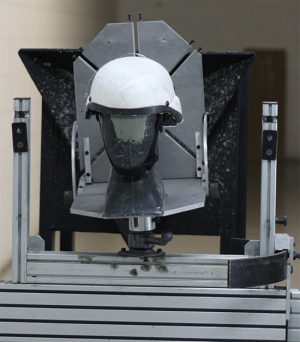Researchers conquer ballistics armour
Research news
It is only nine years since the Defence Science and Technology Organisation (DSTO) put out a challenge to Australian scientists - find a way to put curves into ballistics materials. At the time, it seemed insurmountable. In ballistic fabrics alone, the stiffness of the fibres made it impossible to bend without wrinkling the material.
But ballistics fabric experts at Deakin couldn’t resist the challenge. They chose the most difficult shape they could think of – the combat helmet – which has the deepest draw and tightest radius of curvature of any ballistics equipment – and set their sights on solving the problem.
The results were outstanding. Now, the researchers, from Deakin’s Institute for Frontier Materials, have helped develop the capability to produce shapes that would enable the manufacture of non-spliced combat helmet shells that would be lighter, stronger, better performing and cheaper to produce than previous designs.
Deakin chief investigator Dr Minoo Naebe and research engineer Mr Madhusudan Suryanarayana worked in collaboration with the Defence Materials Technology Centre (DMTC), the Victorian Centre for Advanced Materials Manufacturing (VCAMM), Pacific ESI, Ballistic and Mechanical Testing, DSTO and independent manufacturer Australian Defence Apparel (ADA).
The team developed a unique process – Double Diaphragm Deep Drawing (D4) – to curve and harden the Kevlar-style ballistic fibres into the correct shape. They designed a special plant that uses thermal (heat) forming to shear the fibres in ultra-high molecular weight ballistic fabric – and managed to achieve perfectly shaped shells that are 20 to 30 per cent lighter than current helmets.
“The technology will help Australian industry to deliver world class armour at lower cost to the Australian Defence Force, and allied military and paramilitary customers,” said Deakin research engineer, Mr Madhusudan Suryanarayana.
He explained that one important benefit of the D4 process is that it has eliminated the need to cut or splice the fibres, as in existing helmets, thus avoiding any compromise in strength - and improving the mechanical and ballistic performance.
“Current standard issue ballistic combat helmets are made with a combination of spliced high tensile synthetic fabrics (Aramid-based), such as Kevlar, and are put together by hand through expensive matched metal tooling,” he said. “With our process, the labour intensive manual lay-up is no longer needed and we can use a range of high modulus fibre systems, including carbon fibre composites.”
The helmet shells meet the highest safety standards, including the requirements outlined in the US standard for Advanced Combat Helmets (ACH). They have passed stringent testing at Ballistic and Mechanical Testing in Port Melbourne. During evaluation, they exceeded the specified US ballistics requirements and passed anvil compression tests performed at Deakin, withstanding 1.7 kN of force from above and 1.3 kN from the side.
The VCAMM team, which includes Project Manager and D4 inventor, James Sandlin, and Mr Stuart Thomas, explained that D4 is the world’s fastest composite forming process, taking only 20 minutes to produce each shell, as opposed to the 45 minutes to one hour of current techniques.
“There are also numerous non-military potential applications,” said Mr Sandlin. “The technology could be applied in areas as diverse as aerospace, automotive, shipping, construction, furniture, sports, or radomes (radar covers).”
“The technology is ready to go and the team is looking forward to exploring commercial ventures with industrial partners,” he added.
Share this story
 The helmet shells meet the highest safety standards - passing stringent ballistic and mechanical testing.
The helmet shells meet the highest safety standards - passing stringent ballistic and mechanical testing.
